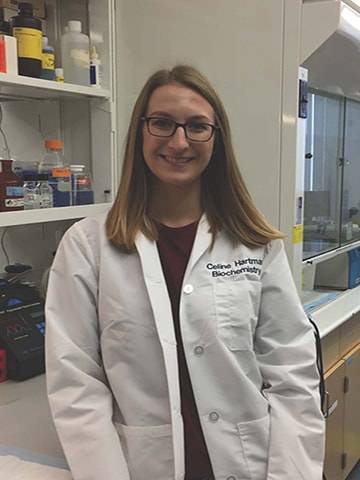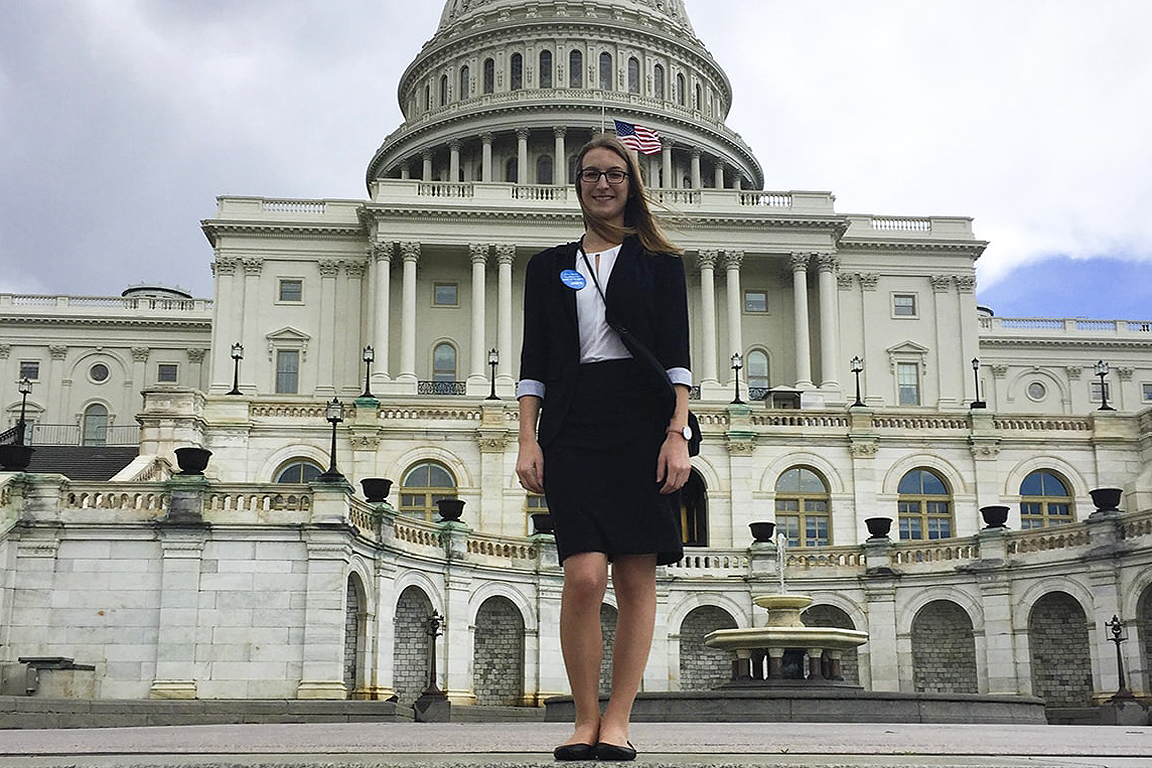SLU Student Researcher Advocates on Capitol Hill for Biomedical Research
A Saint Louis University student researcher recently advocated the importance of biomedical research to federal legislators.
Celine Hartman, a fourth-year graduate student, spent April 6 on Capitol Hill with a team of student researchers from the American Society for Biochemistry and Molecular Biology (ASBMB).
Hartman works in the lab of David Ford, Ph.D., in the department of biochemistry and molecular biology.
ASBMB’s Hill Day gave 19 undergraduates, graduate students and postdoctoral scholars from across the country the chance to participate in meetings with lawmakers and congressional staff about the work they are doing. The 2017 participants came from universities which included Johns Hopkins School of Medicine, Emory University, Brown University, University of North Carolina Chapel Hill, Oregon Health and Science University and the University of Wisconsin-Madison.
“Celine had the initiative to apply for this wonderful program,” Ford said. “Beyond performing exciting and cutting edge research it is great that this opportunity is available to students, which allows them to understand the importance of science as an important investment by our government and to advocate science to politicians.”
The participants emphasized the critical role that federal investments in research plays in supporting the nation’s scientific enterprise and how those investments lead to improvements in the quality of life and well-being of Americans.
“I think people may not realize how cutting the NIH will affect the general public,” Hartman said. “By cutting basic biomedical research funding, pharmaceutical companies will now have to perform the same fundamental research we are working on, instead of finding drugs to push through to clinical trials. This will, in turn, increase the price of the pharmaceutical drugs even more.”
Hartman came to SLU in 2013 after graduating from Bradley University with a biology degree. Her thesis project is focusing on determining the biochemical mechanisms that a pro-inflammatory family of lipids, chlorinated lipids, cause endothelial dysfunction leading to multi-organ failure during sepsis.
She joined the ASBMB last year.
What interested you about this field of research?
I’ve always had an interest in cardiovascular research, after having some heart problems when I was a kid. My mom (and many other family members) is a nurse, so I’ve been exposed to the medical field all my life.

I knew I didn’t want to become a medical doctor, but I wanted to continue my education after Bradley to have more job options. After meeting and talking to Dr. Ford about the research in his lab, it was an easy decision to join his lab.
What do you do in the lab?
Our lab studies biochemical mediators of sepsis and cardiovascular disease. Specifically, we study a class of lipids (fats) which are chlorinated. We are working on utilizing these lipids as a new diagnostic marker to identify these inflammatory diseases sooner, as well as finding new targets for drug therapies. As a graduate student in the lab, I design, perform, and analyze the results of experiments, so every day is a new adventure.
Why did you feel like it was important to do this?
With the recent political events in our country, conversations with policymakers regarding the importance of STEM research are more important than ever. The FY18 fiscal year proposed 20 percent cut to the NIH budget is shocking. The proposed cut would essentially prevent any new grants from being funded, which would be devastating to all biomedical research. As a young scientist preparing to enter the work force in the next one to two years, I wanted the opportunity to tell policymakers my story and why we need sustainable funding to the NIH. I was able to advocate on behalf of all young scientists in Missouri and beyond.
What did you do on Capitol Hill?
In preparation for Hill Day, we had a webinar training where we discussed the basics of the federal budget, how NIH/NSF are funded, and what the proposed budget cuts could mean. We also received a lot of information about each member of Congress that we would be meeting with. We prepared by reviewing each person’s story, voting history and participation in committees. On Hill Day, we were paired into groups with one other student and one faculty member who is on the Public Affairs Advisory Committee. My group met with Congressional members (both senators and representatives) from Missouri, Pennsylvania and West Virginia.
What was your main message to legislators?
During each meeting, we discussed our own research and why we participated in the Hill Day. The main message that we wanted to discuss was about the proposed budget cuts. We would reiterate that we greatly appreciate the support to the NIH thus far, as all of our research progress is possible due to the federal funding of the NIH. We also discussed how we hoped to continue to see sustainable funding over the next few years and how detrimental the proposed budget cuts would be to our own research.
What did you learn while on the Hill?
It was very interesting to see the other side of research funding that we don’t think of normally. Funding the NIH has strong bipartisan support, so the conversations were very supportive of our research and the potential implications. Moving forward, I believe conversations like the ones that I had will help support NIH funding and continue to provide jobs for young scientists like myself.
What has been your experience at SLU been like?
My experience at SLU has been great so far. Everyone, ranging from the professors to the staff to the administration, is very supportive of the students. Dr. Ford and Carolyn Albert (our lab manager) are amazing mentors to be around every day, and they have been so encouraging through my last four years here. When a student can be confident in themselves and the work they are doing, I think big opportunities like this are much easier to obtain. During my interview, I felt more comfortable with the people here than anywhere else I interviewed. I spent 40+ hours a week with the people in my lab, and I knew these people were easy to get along with.
The American Society for Biochemistry and Molecular Biology (ASBMB) is a nonprofit scientific and educational organization with over 12,000 members. Founded in 1906, the Society publishes the Journal of Biological Chemistry, Molecular & Cellular Proteomics and the Journal of Lipid Research.
Established in 1836, Saint Louis University School of Medicine has the distinction of awarding the first medical degree west of the Mississippi River. The school educates physicians and biomedical scientists, conducts medical research, and provides health care on a local, national and international level. Research at the school seeks new cures and treatments in five key areas: infectious disease, liver disease, cancer, heart/lung disease, and aging and brain disorders.


















